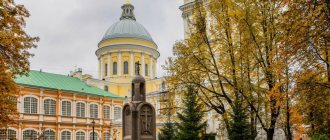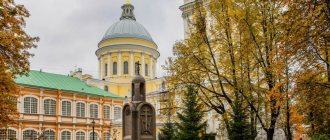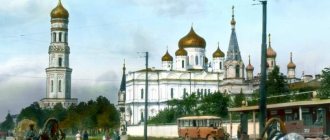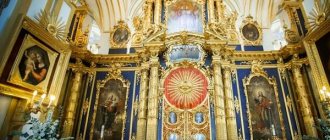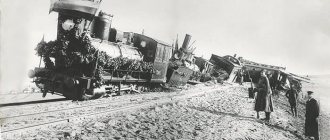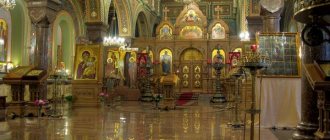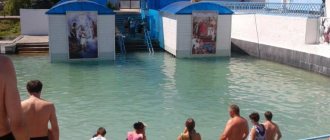Holy Trinity Alexander Nevsky Lavra is a male Orthodox monastery in St. Petersburg.
The monastery is a large complex, which includes: the Holy Trinity Cathedral, several churches and cemeteries (now necropolises), buildings for various purposes, including monastery buildings, as well as a garden, monuments and museums.
The Alexander Nevsky Lavra is the first and largest monastery in St. Petersburg.
The monastery was given Lavra status in 1797.
Lavra is the name of some of the largest male Orthodox monasteries that have special historical and spiritual significance.
The Holy Trinity Alexander Nevsky Lavra is located near the historical center of St. Petersburg, at the eastern end of Nevsky Prospect - immediately behind Alexander Nevsky Square (the monument to Alexander Nevsky).
The establishment of the monastery dates back to the reign of Peter the Great. It was on the initiative of Peter I, from the beginning of 1710, that the monastery was founded. At that time, the monastery was located outside the city, and one of its main goals was to protect and spread the Christian faith and Christian culture. Peter himself conceived the monastery as an exemplary one, as well as a charitable, correctional, educational and medical institution - however, and perhaps fortunately for the monastery (or not), these ideas were never realized.
Construction of the first church of the monastery began most likely in June 1712. The consecration of the first wooden church in the name of the Annunciation of the Blessed Virgin Mary took place on March 25 (April 7, new style) 1713 - on the feast of the Annunciation of the Blessed Virgin Mary.
The first and only member of the brotherhood at that time was the rector of the monastery, “archimandrite of the newly created monastery in St. Petersburg” Feodosius (Yanovsky). The monastics began to inhabit the monastery when it was already somewhat settled.
The project of the architectural complex of the monastery in stone was developed by the architect Domenico Trezzini. Subsequently, other architects worked on the construction and restoration of the monastery buildings.
Over time, the monastery was completed, remodeled and expanded. Under him, a school was founded, the main monastery church (the Cathedral of the Holy Trinity) was erected, cemeteries were laid out nearby, and the relics of saints were transferred to the monastery, including the relics of the holy noble prince Alexander Nevsky.
Thus, the monastery grew into a whole vast system of majestic and monumental buildings.
After the publication of the Decree on the separation of church and state (1918), the monastery continued to operate until 1932. Afterwards came the reorganization of the monastery and various workshops, organizations and institutions were located on the territory of the monastery. During the Great Patriotic War, it was a military hospital.
The revival of the monastic monastery began in the fall of 1996. Since then, its restoration and revival of crafts have continued.
Choice of location and name of the monastery
The place chosen for the construction of the monastery and the dedication of the monastery to the holy prince Alexander Yaroslavich Nevsky had historical significance, and this was explained by the fact that, as it was then believed, on the site of the monastery, the Novgorodians defeated the Swedes in the Battle of Neva in 1240. However, the famous battle took place further up the Neva, where a wooden church was built in the 16th century to commemorate the victory over the Swedes. However, the legend existed, and perhaps it was based on a completely different battle - which took place on May 18, 1301, when the Novgorodians, led by Alexander’s son, Prince Andrei, also defeated the Swedes and destroyed the Landskrona fortress built by them in 1300, which stood not far from those places (Okhtinsky Cape) where the Alexander Nevsky Lavra is located.
Despite the above, if we take into account that the monastery was planned to be built during military operations in the fight against the Swedes for possession of the mouth of the Neva, and on June 13, 1710, Vyborg was taken, then the historical connection with the name of the monastery is undeniable.
Trinity Cathedral of the Alexander Nevsky Lavra
The main building in the architectural ensemble of the Alexander Nevsky Lavra is the Trinity Cathedral. This is one of the most beautiful churches in St. Petersburg.
The design of the building in 1776 was developed by I. Starov. Empress Catherine II really liked the concept proposed by the architect. In 1778, in the presence of Metropolitan Gabriel (Petrov) of St. Petersburg and Novgorod, a ceremony was held to lay the first stone in the foundation of the future cathedral.
The main work was completed in 1786, after which the builders began finishing the temple. The illumination of Trinity Cathedral took place in 1790. The relics of St. were solemnly brought into the building amid a cannon fire. Alexander Nevsky.
Trinity Cathedral is a temple with one dome and two towers that serve as bell towers. Architecturally, the building belongs to early classicism.
The dome of the Trinity Cathedral is one of the largest in St. Petersburg. It is mounted on a massive drum tower with needle-shaped windows. Bell towers complement the architectural appearance of the building. Starov placed the towers on both sides of the main entrance. Above the entrance is a massive portico supported by six Doric columns.
The color of the façade is classic yellow-white. The walls are decorated with pilasters and white columns. At Starov's request, the famous sculptor F. Shubin created bas-relief panels depicting biblical scenes. The panels were fixed above the southern and northern porticoes of the building.
Above the main entrance there is a panel “Sacrifice of Solomon”. The architect enclosed the massive wooden doors in a small snow-white portico, in the upper part of which there is a sculptural group: two golden angels holding the Order of St. Alexander Nevsky.
From the inside, the main hall of the cathedral is a cross. The high vault is supported by huge columns that divide the vestibule into three rectangular rooms. Daylight pours in through the sixteen windows of the domed drum.
The Trinity Cathedral has a unique iconostasis made of marble by the Italian master A. Pinketti. The icons were painted by I. Akimov, G. Ugryumov and J. Mettenleiter.
The painting of the cathedral walls that has come down to us dates back to 1862, it was done by the artist P. Titov. The stucco molding for the walls was made by D. Fontana. Numerous sculptures of holy saints were created by F. Shubin.
The altar of the Trinity Cathedral is decorated with an image of the Virgin Mary by R. Mengs. Above the place where members of the imperial family were supposed to be during the service, a portrait of Catherine II by D. Levitsky was placed.
During the revolutionary years, the Trinity Cathedral of the Alexander Nevsky Lavra was destroyed, many interior items were lost. In 1933, an exhibition of scientific achievements began working in the temple, and later a warehouse was organized here.
The temple was returned to the church in 1956, after which its restoration began. Nowadays, the Trinity Cathedral is a specially protected cultural heritage site of Russia.
The temple is a tribute to the heroes
Since its construction, the Trinity Cathedral of the Alexander Nevsky Lavra in St. Petersburg has belonged to the category of so-called capitular, that is, order churches. In this case we are talking about the Order of St. Alexander Nevsky. Initially, the limit dedicated to him was located under the south tower, but in 1838 it was abolished.
As a sign of special respect for all those awarded this award, a special hall was opened for them in 1791 in the Fedorovsky building adjacent to the cathedral, and a little later a relief image of the order appeared above the entrance to the temple.
History in dates
- 1710 - Peter I decided to build the largest monastery in the country on the Black River dedicated to Alexander Nevsky.
- 1713 – the first wooden church was built and consecrated.
- By 1720, a school for children of clergy, a printing house and an almshouse for retired soldiers were opened.
- May 29, 1723 – the relics of A.Ya. Nevsky were transported here.
- The middle and end of the 18th century - large-scale construction of buildings, churches and the main cathedral.
- 1797 - awarded the status of a monastery, i.e. a large monastery of great religious and historical significance for the country.
- In the 19th century, the Lavra flourished and expanded. Pilgrims began to come here. The collection of relics and valuable art objects was replenished.
- 1930s - Soviet authorities prohibit religious services, all monasticism is arrested.
- Only in 1957 was the parish restored, although all the buildings were damaged after the war.
- 1996 - restoration work began, the main ones were completed only after 10 years.
- 2000 - the state transferred the facility back to the authority of the diocese.
lite.35photo.pro
The first damn thing is lumpy
This first Trinity Cathedral of the Alexander Nevsky Lavra, which has not survived to this day, was a grandiose structure, decorated with two bell towers with spiers on the tops. In 1719, a complex of preparatory work began. The construction of the building, which lasted for eleven years, was completed by 1733, but it soon became clear that serious errors had been made in its layout.
In particular, the soil on which the foundation was built was not sufficiently strengthened. As a result, uneven settlement of individual parts of the cathedral occurred, which caused cracks to appear on its vaults. The commission created in 1744 came to the conclusion that there was a real danger of the building collapsing and the impossibility of its operation.
The complete dismantling of the temple, begun in 1753 and carried out under the leadership of State Councilor Ivan Yakovlevich Rossi, the namesake of the famous Karl Rossi, took two years. After the first Trinity Cathedral of the Alexander Nevsky Lavra in St. Petersburg was completely dismantled, for six years it remained the only unfinished element of the entire monastic complex built by that time.
Project by D. Trezzini
Initially, it was planned that the complex of monastery buildings, symmetrically spread over the entire space allocated to it on the Neva bank, was to become another defensive structure in the southeast of the young capital, so it was built according to all the rules of fortification.
It was planned to connect the monastery with St. Petersburg by a road laid through the thicket of the forest, called on the plan as “Nevskaya Perspektiva” - the future main thoroughfare of the city, Nevsky Prospekt.
The architectural center of the monastery under construction was to be a temple, the place for which was indicated on the plan by Trezzini himself, and from which he intended to begin laying Nevsky Prospekt. The creation of the temple project was entrusted to the young architect T. Schwertfeger, who had recently arrived from Germany but had managed to gain fame, an ardent supporter of the German Baroque style that was fashionable in those years.
The highest command of Catherine II
The new stage of construction of the cathedral dates back to the reign of Empress Catherine II, by whose command a competition for cathedral designs was established in 1763. The most titled architects of that time took part in it, such as Yu. M. Felten, A. F. Kokorin, F. F. Vist, S. A. Volkov and a number of others. None of the submitted works received the highest approval, and the construction project was frozen for another eleven years.
Only in 1774, when further delays were impossible - the monastery was built, but there was no central church - Catherine II ordered to entrust the project of its creation to the Russian architect Ivan Yegorovich Starov. Work on the technical documentation took two years, and in 1776, after the highest approval of the project, its author was entrusted with construction management. The Empress was personally present at the ceremonial laying of the cathedral. Immediately after the end of the celebrations, with blessings, we began work.
Orthodox Life
The solemn consecration of the cathedral in the name of the Holy and Life-Giving Trinity and the transfer of the relics of Saint Prince Alexander Nevsky into it took place on August 30, 1790. The cathedral has a rich interior decoration.
The most important event in the monastery in the last third of the 18th century was the construction of the main cathedral church. The development of the project was entrusted to the architect I. E. Starov in 1774. In February 1776, Catherine II approved the project.
On August 30, 1778, on the day of the transfer of the relics of St. Alexander Nevsky, Metropolitan Gabriel (Petrov), in the presence of the Empress, held a ceremony to lay the foundation of the temple. The construction of the cathedral and its external decoration were completed by 1788, and the painting of the walls, vaults and dome was completed by August 1790. The solemn consecration of the cathedral in the name of the Holy and Life-Giving Trinity and the transfer of the relics of Saint Prince Alexander Nevsky into it took place on August 30, 1790. The cathedral has a rich interior decoration. Catherine II donated precious liturgical objects and a number of paintings on church subjects for the temple, created by major masters of Western European art and Russian academic artists.
In the spring of 1922, most of the church valuables of the cathedral were requisitioned, the shrine of the Holy Blessed Grand Duke Alexander Nevsky was opened, the relics were confiscated, and the silver sarcophagus was transferred to the Hermitage.
On December 20, 1933, the cathedral was closed, its premises were rented out to various organizations, and the paintings were transferred to the Museum Fund. In 1956, a resolution was adopted to return the Trinity Cathedral to believers. The temple building was heavily damaged by the actions of tenants and from shelling during the war, so in 1957-1960. The cathedral was repaired using funds from the Patriarchate, Leningrad and other dioceses and donations from believers.
On September 12 (August 30), 1957, the consecration of the main altar took place, and from that time parish life resumed in the cathedral.
On June 3, 1989, the relics of St. Alexander Nevsky were returned from the Museum of the History of Religion and Atheism to the Holy Trinity Cathedral. Currently, the cathedral houses many shrines revered by believers.
In front of the main cathedral of the monastery there is a “Communist site”, in 2009 renamed the Cossack cemetery. Participants in the defense of Petrograd, victims of the Kronstadt rebellion, old Bolsheviks, hereditary St. Petersburg workers, famous scientists and engineers - this is the composition of this unique Soviet necropolis. Burials, which stopped in the late 1930s, were resumed during the Great Patriotic War, when participants in the Battle of Leningrad were buried at the Communist site. In total there are about 340 graves.
Based on materials from lavra.spb.ru
Revival of the Lavra
The Holy Trinity Alexander Nevsky Lavra itself was revived as a monastery only in 1989. At the same time, the charter was re-adopted and the persons who occupied the main administrative positions in it were determined, such as housekeeper, dean, sacristan, confessor, and so on. At the same time, the community in charge of all affairs in the Holy Trinity Cathedral of the Alexander Nevsky Lavra was abolished. This was a consequence of its loss of status as an independent parish church. Finally, all the buildings that were previously part of the monastery complex were returned to the Lavra in 2000.
The beginning of the era of total atheism
With the beginning of Bolshevik rule, the Trinity Cathedral of the Alexander Nevsky Lavra did not escape the process of general expropriation of values belonging to the church. Everything that, in the opinion of the new authorities, was of value was removed from it, and a year later the building itself was transferred to the renovationists - representatives of the schismatic movement that emerged after the February Revolution among the clergy who advocated the “renewal of the Church” and tried to get along with the Bolsheviks.
From 1928 to 1933, the Trinity Cathedral of the Alexander Nevsky Lavra belonged to a different branch of the clergy, which went down in history as the “non-rememberers.” This group of clergy refused to compromise with the Soviet government and at their services to prayerfully remember Metropolitan Sergius (Stargorodsky), who worked closely with it. At that time, this seemingly insignificant deviation from the Church Charter could be regarded by the authorities as a political action, and in order to decide on it, a fair amount of courage was required.
The monastery, born by the command of Peter the Great
Historical chronicles indicate that in 1710, having visited the place where the Black River flows into the Neva - that’s what the current Monastyrka river was called in the old days - Tsar Peter I ordered the construction of a monastery there, dedicated to the holy noble prince Alexander Nevsky. His desire was not a momentary whim. These were the years of the war with Sweden, and the help of a heavenly patron, especially one who had experience in defeating the Swedes, was necessary. The choice of the place to build the monastery was the result of the erroneous opinion that existed in those years that it was at this place that Prince Alexander won his victory.
Having founded his great city “in spite of his arrogant neighbor,” Tsar Peter put its construction on a grand scale. A master plan was developed, according to which the city streets were drawn out in a strict geometric order. The best foreign architects were invited to construct government buildings, temples and palaces of nobles. With the labor of thousands of serfs, driven from all over Russia, Northern Venice rose from the swamps of the Finnish swamps.
In the midst of work, when the bastions of the Peter and Paul Fortress were being built and the first ships of the Russian fleet were launched from the newly built Admiralty Shipyard, the sovereign became concerned with the need to create a spiritual center. Tsar Peter wished that honest monks, away from the noise of the city, would constantly pray for God’s blessing to be sent down to all his endeavors. In addition, as stated above, the war with the Swedes was in full swing, and the memory of the saint who had once defeated them should have inspired the current warriors.
